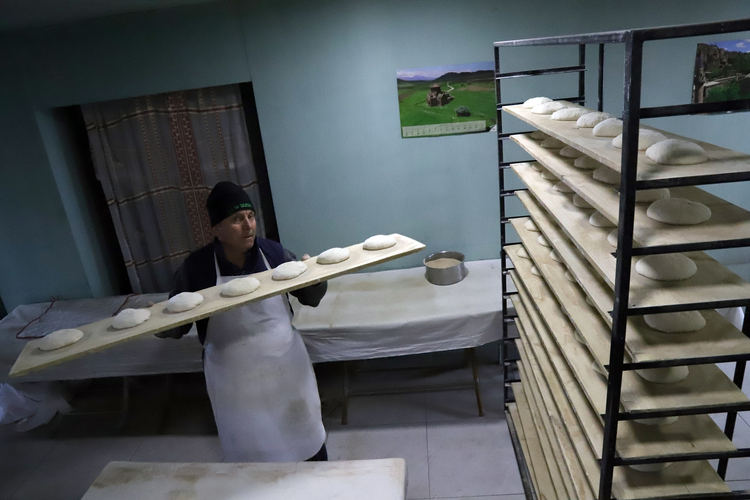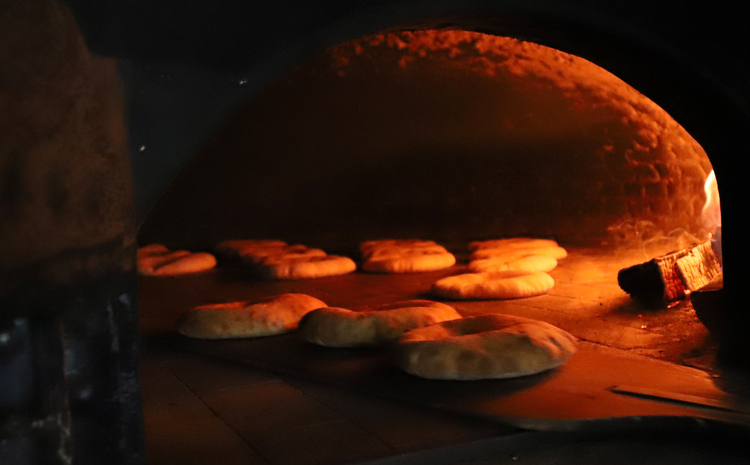Gelveri bread (Gelveri ekmeği) is a traditional flatbread type specific to the Güzelyurt district of Aksaray province, registered with a geographical indication (Registration No: 1040, 07.03.2022). This bread, which has a round shape and a soft inner structure, is produced in the characteristic rock formations and historical stone ovens of the Cappadocia Region. The geographical boundary is limited to the Güzelyurt district of Aksaray.
History
The roots of Gelveri bread extend to the ancient periods of the region. Güzelyurt (formerly Gelveri) has been settled since the Paleolithic Age; it has hosted Hittite, Roman, Byzantine, Seljuk, and Ottoman civilizations. In the 1924 Lausanne Exchange, the Greek population in the region migrated to Greece, while the Turks who came from Kavala continued the Gelveri bread tradition. The stone ovens in the gardens of historical Greek houses were used jointly by the local people, and production was passed down from generation to generation.
Components and Production Technology
Materials
Whole wheat flour (from wheat grown in Aksaray), water (Güzelyurt underground spring water, pH 6.7-7.0), salt, and sourdough starter (ekşi maya) are used. It contains no additives.
Sourdough Starter Preparation
5 liters of water, 2 kg of flour, and 10 g of salt are mixed and left to rest for 10 hours; it is matured for 10 days with daily stirring. The starter contains Lactobacillus spp. and the yeasts Saccharomyces cerevisiae and Pichia kudriavzevii.
Dough and Fermentation
50 kg of flour, 3 kg of sourdough starter, 700 g of salt, and 30 L of water are kneaded. Hand kneading takes 30-35 minutes. The dough is fermented for 1-1.5 hours (27°C is ideal).

Fermentation (Anadolu Ajansı)
Shaping and Baking
The dough is divided into 380 g portions (bezeler), rounded, and left for an intermediate fermentation of 30-35 minutes. The stone ovens are heated to 300-400°C (the whitening of the stone indicates it is ready). The portions are opened by hand, a hole is made in the center, and they are placed in the oven; they bake at 350°C in 4-5 minutes.

Baking (Anadolu Ajansı)
Microbiological and Nutritional Characteristics
The sourdough starter contains 9.46 log cfu/g Lactobacillus spp. and 8.45 log cfu/g yeast. Lactic acid bacteria produce lactic and acetic acid, giving the bread its characteristic sourish taste. Whole wheat flour is nutritious with its fiber (beta-glucan), vitamin (A, E, B group), and mineral (selenium, iron) content. Sourdough fermentation breaks down phytic acid, increasing mineral absorption. Its glycemic index is low (≤55), and it shows a prebiotic effect that regulates the gut microbiota.
Physical Durability and Storage
Thanks to its high crust/crumb ratio and sourdough, it maintains its freshness for 2-3 months. It can be stored in a deep freezer; when thawed, it returns to its original freshness. Sourdough slows down starch retrogradation, delaying staling; it prevents mold formation with antifungal compounds.
Scope of Geographical Indication
Gelveri bread; an application for registration was made by the Güzelyurt District Governorship on 08.03.2021, and it was taken under protection with a Geographical Indication Registration Certificate of the Designation of Origin (Mahreç İşareti) type on 07.03.2022. According to the Turkish Patent and Trademark Office, all production stages (kneading, baking, packaging) must take place within the boundaries of GüzelyTurt. Inspections are carried out at least once a year under the coordination of the Güzelyurt District Governorship. The inspection is carried out by an expert team of at least 3 people.


